Edge of Darkness (1943 film)
Last updated| Edge of Darkness | |
|---|---|
 Theatrical release poster | |
| Directed by | Lewis Milestone |
| Screenplay by | Robert Rossen |
| Based on | The Edge of Darkness by William Woods |
| Produced by | Henry Blanke |
| Starring | |
| Cinematography | Sid Hickox |
| Edited by | David Weisbart |
| Music by | Franz Waxman |
Production company | |
| Distributed by | Warner Bros. |
Release dates |
|
Running time | 119 minutes |
| Country | United States |
| Language | English |
| Budget | $1,653,000 [2] |
| Box office | $3,669,000 [2] $2.3 million (US rentals) [3] |
Edge of Darkness (a.k.a. Norway in Revolt) is a 1943 World War II film directed by Lewis Milestone that features Errol Flynn, Ann Sheridan, and Walter Huston. [4] The feature is based on a script written by Robert Rossen which was adapted from the 1942 novel The Edge of Darkness by William Woods. [5]
Contents
Plot
Norway, 1942. In the Nazi-occupied fishing village of Trollness, Dr. Martin Stensgard (Walter Huston) and his wife (Ruth Gordon) hold on to the pretense of gracious living and ignore the occupiers. The doctor would also prefer to stay neutral, but is torn. Kaspar Torgersen (Charles Dingle), his brother-in-law, the wealthy owner of the local fish cannery, collaborates with the Nazis. However, the doctor's daughter, Karen (Ann Sheridan), is a resistance member, romantically involved with its leader, Gunnar Brogge (Errol Flynn). Complicating matters further, the doctor's son, Johann (John Beal), has just returned from school in Oslo. Unfortunately, he comes under the influence of his Nazi-sympathizer uncle. Though she loves her brother, Karen makes it known to the townsfolk that Johann is a Quisling.
A key group of resistance members, headed by Gunnar and Karen, anxiously await a secret arrival of arms from a British submarine. They hide the weapons in a cellar and call upon the townsfolk to delay violence until the opportune moment. One evening, Karen, on her way to a meeting, is grabbed by a German soldier and disappears, while Gunnar frantically searches the town for her. She eventually appears at the meeting, clothes torn and face bruised, indicative that she has been raped. Gunnar loses his perspective after seeing what the Germans have done and prepares to attack without delay. But Karen and the others convince him that it is still not yet the time.
After the meeting, Karen's father, in anger, murders a German soldier. The Nazi commandant (Helmut Dantine) orders all suspected resistance leaders held for public execution. The next morning, they dig their own graves in the town square. Then, they hear singing and discover the townsfolk have armed themselves with the smuggled arsenal. The local pastor fires a machine gun from the church tower, and the townsfolk follow suit. They re-capture their village and load the women and children onto fishing boats bound for England. At the local hotel, which serves as German headquarters, and where Karen's brother has moved, preparations are made for defense. Gunnar, Karen, her father, and other resistance members march through the forest toward the hotel. Johann, experiencing a change of heart, warns the rebels from the hotel they are walking into a crossfire trap. The Germans kill Johann, then engage in battle with the rebels, who finally seize the hotel. The Nazi commandant commits suicide. Later, surviving resistance members take to the hills to continue their fight against occupation.
Cast
|
|
Production
Original Novel
Edge of Darkness was based on the debut novel of William Woods. Warner Bros. bought the film rights in January 1942 for $30,000. [6] The novel was published on April 9, the second anniversary of the German invasion of Norway. [7]
Development
Henry Blanke was assigned to produce, Robert Rossen to write the script and Lewis Milestone to direct. Milestone later told the press:
It is twelve years now since I made All Quiet on the Western Front . That film embodied the retrospective disillusionment toward another war. In Edge of Darkness we are making a picture that has done away with disillusionment. We know the enemy we are fighting and we are facing the stern realities of the present war. The moral in Edge of Darkness is that 'united we stand, divided we fall'. That is the keystone for victory in all the democracies. [8]
"I can't think of a story about which I could be more enthusiastic," said Blanke about Edge of Darkness. [9]
The job of writing the script was given to Robert Rossen. Milestone later said Rossen "hit on an idiom for the dialogue that had nothing to do with Norway but derived mainly from the language he knew best - the speechways of New York's East Side. Since nobody else knew the difference the idiom worked admirably." [10]
Casting
Ann Sheridan and Humphrey Bogart were announced as stars. [11]
Eventually Bogart dropped out and was replaced by Errol Flynn. [12] [13]
The cast included Helmut Dantine who had just signed a long-term contract with Warners following his appearance in Casablanca. [14]
There were a large number of actors cast who were best known for their stage work, including Judith Anderson and Ruth Gordon.
Milestone later said "an extremely mixed cast gave some damned good performances." [10]
Shooting
Shooting was to begin in August 1942 but was postponed for two weeks so Errol Flynn could recuperate from bad health. [15] He was meant to do this on his yacht but Hedda Hopper reported he slipped down to Mexico City with a friend for some hunting, and that he "hasn't wanted to do it [the film] from the first", in part because his role was relatively small. Bruce Cabot was listed as a possible replacement if Flynn did not return. [16] Warners pressured Flynn and he eventually returned for filming. [17]
(It was later reported that Flynn had signed a new contract with Warners for four films a year, one of which he was to also act as producer. [18] )
Most of the film was shot in Warner Bros. studios at Burbank with some exteriors in the town of Monterey. [19] Warners rented two of the biggest piers in Monterey and a fleet of Monterey sailing boats; they lined the streets with Norwegian and Nazi flags and signs and cast several locals as extras. [8] The unit returned from Monterey on September 16 to resume studio shooting. [20]
Erskine Caldwell reportedly operated as a technical adviser on the film because he had some experience of Norway. [21]
During filming, Warners added six grave markers with the names of Nazi saboteurs recently executed in the US, for extra realism. [22] Filming ended in November.
Edge of Darkness was one of several films set in occupied Europe, others being The Commandos Strike at Dawn and The Moon is Down . [23]
Milestone later said "Flynn kept underrating himself. If you wanted to embarrass him, all you had to do was to tell him how great he was in a scene he'd just finished playing: he'd blush like a young girl and muttering 'I'm not an actor' would go away somewhere and sit down." [10]
Music
Franz Waxman did the score. He used two main pieces, the Lutheran chorale "A Mighty Fortress is Our God" and the national hymn of Norway. According to one review, "the rest is frankly color orchestration and the necessary filling in. The result is a magnificent build up to an overwhelming emotional climax." [24]
Reception
Contemporary reviews were positive. Bosley Crowther of The New York Times called the film "melodrama [but] strong melodrama, to be sure." [25] Variety described it as "a dramatic, tense, emotion-stirring story of the ravaging of Norway, superbly acted by a fine cast and firmly directed by Lewis Milestone." [26] Harrison's Reports called it "Excellent! ... Lewis Milestone's direction is masterful, and the performances, from the stars to the bit players, are superb." [27] David Lardner of The New Yorker compared the film to The Moon Is Down , writing that both were worth seeing but that Edge of Darkness was slightly better due to rounder characterizations. [28] Filmink magazine called it "definitely Errol's most communist (ish) movie." [29]
The film was one of the five most requested movies by the US Army in April 1943 - the others being My Friend Flicka , Hit Parade of 1943 , Flight for Freedom and Hello, Frisco, Hello . [30] It was also given special screenings to the Sons of Norway organization. [31]
Edge of Darkness was banned in Buenos Aires in 1943 because of its anti-Nazi stance. [32]
Flynn was to follow the movie with To the Last Man (which became Northern Pursuit ) and Captain Horatio Hornblower (which was postponed and then made with Gregory Peck). [33]
Box Office
According to Warner Bros. records, the film earned $2,039,000 domestically and $1,630,000 foreign. [2]
Related Research Articles

Errol Leslie Thomson Flynn was an Australian actor who achieved worldwide fame during the Golden Age of Hollywood. He was known for his romantic swashbuckler roles, frequent partnerships with Olivia de Havilland, and reputation for his womanising and hedonistic personal life. His most notable roles include Robin Hood in The Adventures of Robin Hood (1938), which was later named by the American Film Institute as the 18th greatest hero in American film history, the lead role in Captain Blood (1935), Major Geoffrey Vickers in The Charge of the Light Brigade (1936), and the hero in a number of Westerns such as Dodge City (1939), Santa Fe Trail, Virginia City, and San Antonio (1945).

Clara Lou "Ann" Sheridan was an American actress and singer. She is best known for her roles in the films San Quentin (1937) with Humphrey Bogart, Angels with Dirty Faces (1938) with James Cagney and Bogart, They Drive by Night (1940) with George Raft and Bogart, City for Conquest (1940) with Cagney and Elia Kazan, The Man Who Came to Dinner (1942) with Bette Davis, Kings Row (1942) with Ronald Reagan, Nora Prentiss (1947), and I Was a Male War Bride (1949) with Cary Grant.
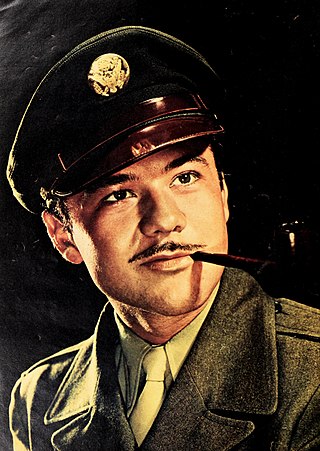
Turhan Bey was an Austrian-born actor of Turkish and Czech-Jewish origins. Active in Hollywood from 1941 to 1953, he was dubbed "The Turkish Delight" by his fans. After his return to Austria, he pursued careers as a photographer and stage director. Returning to Hollywood after a 40-year hiatus, he made several guest appearances in 1990s television series including SeaQuest DSV, Murder, She Wrote and Babylon 5 as well as a number of films. After retiring, he appeared in a number of documentaries, including a German-language documentary on his life.
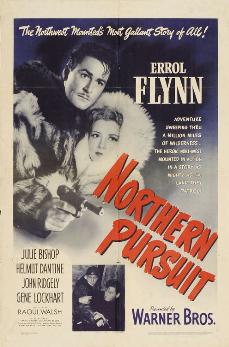
Northern Pursuit is a 1943 American World War II adventure thriller film directed by Raoul Walsh and starring Errol Flynn as a member of the Royal Canadian Mounted Police (RCMP) who tries to uncover a Nazi plot against the Allied war effort. The film was set in Canada during the early years of the war.

Gentleman Jim is a 1942 film directed by Raoul Walsh and starring Errol Flynn as heavyweight boxing champion James J. Corbett (1866–1933). The supporting cast includes Alexis Smith, Jack Carson, Alan Hale, William Frawley, and Ward Bond as John L. Sullivan. The movie was based upon Corbett's 1894 autobiography, The Roar of the Crowd. The role was one of Flynn's favorites.

Adventures of Don Juan is a 1948 American Technicolor swashbuckling adventure romance film directed by Vincent Sherman and starring Errol Flynn and Viveca Lindfors, with Robert Douglas, Alan Hale, Ann Rutherford, and Robert Warwick. Also in the cast are Barbara Bates, Raymond Burr, and Mary Stuart. The film was distributed by Warner Bros. and produced by Jerry Wald. The screenplay by George Oppenheimer and Harry Kurnitz, based on a story by Herbert Dalmas, has uncredited contributions by William Faulkner and Robert Florey.
The film appearances of movie actor Errol Flynn (1909–1959) are listed here, including his short films and one unfinished feature.

That Forsyte Woman is a 1949 American romantic drama film directed by Compton Bennett and starring Greer Garson, Errol Flynn, Walter Pidgeon, Robert Young and Janet Leigh. It is an adaptation of the 1906 novel The Man of Property, the first book in The Forsyte Saga by John Galsworthy.
Seton Ingersoll Miller was an American screenwriter and producer. During his career, he worked with film directors such as Howard Hawks and Michael Curtiz. Miller received two Oscar nominations and won once for Best Screenplay for the 1941 fantasy romantic comedy film, Here Comes Mr. Jordan, along with Sidney Buchman.

The Sun Also Rises is a 1957 American drama film adaptation of the 1926 Ernest Hemingway novel of the same name directed by Henry King. The screenplay was written by Peter Viertel and it starred Tyrone Power, Ava Gardner, Mel Ferrer, and Errol Flynn. Much of it was filmed on location in France and Spain as well as Mexico in Cinemascope and color by Deluxe. A highlight of the film is the famous "running of the bulls" in Pamplona, Spain and two bullfights.

Never Say Goodbye is a 1946 American romantic comedy film directed by James V. Kern and starring Errol Flynn, Eleanor Parker, and Lucile Watson. Produced and distributed by Warner Brothers, it is about a divorced couple and the daughter who works to bring them back together. It was Errol Flynn's first purely comedic role since Footsteps in the Dark.

Cry Wolf is a 1947 American mystery film noir directed by Peter Godfrey and starring Errol Flynn, Barbara Stanwyck and Geraldine Brooks. It was produced and distributed by Warner Bros. It is based on the 1945 novel of the same name by Marjorie Carleton.
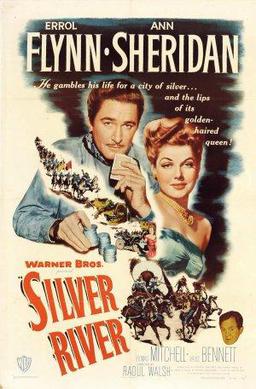
Silver River is a 1948 American western film directed by Raoul Walsh and starring Errol Flynn, Ann Sheridan and Thomas Mitchell. The film is based on a Stephen Longstreet story that was turned into a novel. It was produced and distributed by Warner Bros.

The Sins of Rachel Cade is a 1961 drama film directed by Gordon Douglas and starring Angie Dickinson in the title role, as well as Peter Finch and Roger Moore who compete for her love.

Adventures of Captain Fabian or Adventure in New Orleans is a 1951 American adventure film directed by William Marshall and starring Errol Flynn, Micheline Presle, Vincent Price, Agnes Moorehead and Victor Francen.
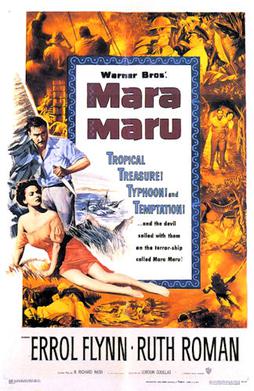
Mara Maru is a 1952 American noir action film starring Errol Flynn, Ruth Roman and Raymond Burr. Directed by Gordon Douglas, it was the last movie Flynn made for Warner Bros where he had started out in Hollywood in 1935.

Montana is a 1950 American Western film directed by Ray Enright and starring Errol Flynn. It was only the second time Flynn played an Australian on screen, the first time being Desperate Journey (1942).
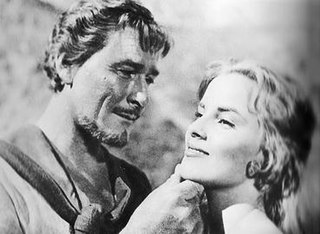
The Story of William Tell is an unfinished film about William Tell. It starred and was produced by Errol Flynn. It commenced filming in Italy in 1953 and was meant to be the directorial debut of Jack Cardiff. It was filmed in CinemaScope. A £10,000 model town set was built near Mont Blanc.
John Wexley was an American writer, best known for his play The Last Mile.

Last of the Buccaneers is a 1950 American Technicolor adventure film directed by Lew Landers and starring Paul Henreid as Jean Lafitte.
References
Notes
- ↑ King 1999, p. 676.
- 1 2 3 Warner Bros financial information in The William Shaefer Ledger. See Appendix 1, Historical Journal of Film, Radio and Television, (1995) 15:sup1, 1-31 p 23 DOI: 10.1080/01439689508604551
- ↑ "Top Grossers of the Season." Variety, January 5, 1944, p. 54.
- ↑ Variety film review; March 24, 1943.
- ↑ Beck, Sanderson. "Review: 'Edge of Darkness (1943)'." Movie Mirrors, 2005. Retrieved: August 22, 2106.
- ↑ "Of local origin." The New York Times , January 24, 1942, p. 13.
- ↑ "Books: Authors", The New York Times, March 28, 1942, p. 15.
- 1 2 Goodman, Ezra. "Hollywood: Norway to Monterey." The New York Times, September 27, 1942, p. X3.
- ↑ "A producer candidly defines his function: Henry Blanke looks upon the producer as a coordinator who can also think." The New York Times, April 4, 1943, p. X4.
- 1 2 3 Higham, Charles; Greenberg, Joel (1971). The celluloid muse; Hollywood directors speak. Regnery. p. 184.
- ↑ "Screen news here and in Hollywood: Ann Sheridan and Humphrey Bogart ... by telephone to The New York Times." The New York Times, May 7, 1942, p. 23.
- ↑ Schallert, Edwin. "Drama: 'Edge of Darkness' to team Sheridan, Flynn." Los Angeles Times, May 29, 1942, p. 8.
- ↑ "Fred Astaire will appear in 'Look Out Below'; Role for Edward Ellis: two films arrive today,'Syncopation' due at Palace, 'My Favorite Spy' will open at Loew's State." The New York Times, May 28, 1942, p. 13.
- ↑ "Screen news here and in Hollywood: Vera Zorina to appear in 'The Hour Before Dawn,' a story by Somerset Maugham." The New York Times, August 5, 1942, p. 16.
- ↑ Schallert, Edwin. "Drama: Hepburn stage play commands high price." Los Angeles Times, August 27, 1942, p. 22.
- ↑ Hopper, Hedda. "Out of the 'Darkness!'." The Washington Post, August 21, 1942, p. 15.
- ↑ Hopper, Hedda. "Woods Hide the Trees!" The Washington Post, August 29, 1942, p. B10.
- ↑ "Of local origin." The New York Times, September 30, 1942, p. 29.
- ↑ Thomas et al. 1969, p. 129.
- ↑ Schallert, Edwin. "Drama: Cesar Romero to play 'Coney Island' threat." Los Angeles Times, September 15, 1942, p. 13.
- ↑ Hopper, Hedda. "Looking at Hollywood." Chicago Daily Tribune, September 10, 1942, p. 24.
- ↑ Pryor, Thomas M. "Film news and comment: Vichy stays ban on American pictures." The New York Times, November 8, 1942, p. X4.
- ↑ Hopper, Hedda. "'Cemented' great and near-great." The Washington Post, August 18, 1942, p. 14.
- ↑ Jones, Isabel Morse. "Music and Musicians: Music for Fox film sets, acquires individuality; New cinema scores being promoted on basis of psychological analysis." Los Angeles Times, March 28, 1943, p. C6.
- ↑ Crowther, Bosley. "Movie Review: 'Edge of Darkness'." The New York Times, April 10, 1943.
- ↑ "Film Reviews." Variety , March 24, 1943, p. 20.
- ↑ "'Edge of Darkness' with Errol Flynn, Ann Sheridan and Walter Huston." Harrison's Reports , March 27, 1943, p. 50.
- ↑ Lardner, David. "The Current Cinema." The New Yorker (F-R Publishing Corp.), April 17, 1943, p. 40.
- ↑ Vagg, Stephen (November 17, 2019). "The Films of Errol Flynn: Part 3 The War Years". Filmink.
- ↑ "If It's 'Escape' you want, it's just around corner." The Washington Post, May 12, 1943, p. 16.
- ↑ "Norway's patriots will see 'Darkness'." The Washington Post, July 10, 1943, p. B8.
- ↑ "Anti-Nazi film barred." The New York Times, September 26, 1943, p. 39.
- ↑ Schallert, Edwin. "Drama: 'Christopher Bean' to costar Woolley, Gish." Los Angeles Times, September 19, 1942, p. A8.
Bibliography
- Hanson, Patricia King, ed. American Film Institute Catalog of Motion Pictures Produced in the United States: Feature Films, 1941-1950. Berkeley, California: University of California Press, 1999. ISBN 0-520-21521-4.
- Thomas, Tony, Rudy Behlmer and Clifford McCarty. The Films of Errol Flynn. New York: Citadel Press, 1969. ISBN 978-0-80650-237-3.
- Woods, William Howard. Edge of Darkness: A Novel of Occupied Norway. New York: J.B. Lippincott Company. 1942.
External links
- Edge of Darkness at the TCM Movie Database
- Edge of Darkness at the American Film Institute Catalog
- Edge of Darkness at IMDb
- Edge of Darkness at AllMovie
- Review of film at Variety
- Edge of Darkness film scene on YouTube
Text is available under the CC BY-SA 4.0 license; additional terms may apply.
Images, videos and audio are available under their respective licenses.